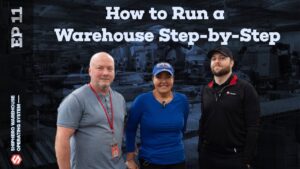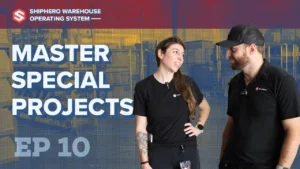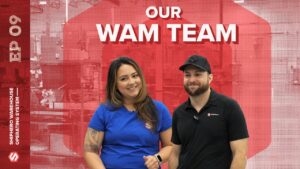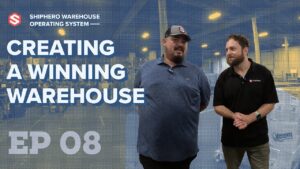Video Transcript
Everything in a warehouse should have a flow.
It comes into the building.
It comes out of the building.
Right now, our pickers start at that end of
the building, and they finish all the way
at the far end.
They put their carts completed over in this
area.
All right.
I'm here today with Ryan, the GM of our Las
Vegas facility.
It's a 200,000 square foot facility that we
operate and serve about a couple dozen clients.
Just want to thank you for the time.
How long have you been running this facility?
As of right now, about eight months.
Pretty short time, pretty big building.
What have you learned over the last eight
months?
Learned a lot specifically about fulfilling
small parcel packages.
Previous companies have been rental industry
and furniture, large format packages, so definitely
learning a lot in terms of how to most efficiently
ship out the small parcel, where we can improve
upon and what sizes matter the most for our
customers.
You're the GM of the building.
Yes.
What does that mean?
What do you do all day?
For me, that means I'm responsible for everything
that is within the four walls.
Any associate that touches a box or misplaces
a product, my job is to make sure that we
have processes in place, and that if we have
processes in place, they're being followed,
so that we can efficiently get our inventory
in, out on time.
What are the metrics that ... Every day you're
working towards a goal, right?
What are those metrics?
What are those goals?
Yeah.
The main metrics and goals is making sure
that we are picking and packing efficiently.
Our standard is pack 50 an hour, pick 50 an
hour.
So making sure that the associates are meeting
those standards, as well as ensuring that
they're set up for success.
That's the biggest thing, because I'm not
going to hold them accountable for not hitting
their numbers if I'm not doing everything
in my power to make sure that they are going
to hit that.
Whether that's better organization on the
floor, more stuff replen-ed, and at the end,
just making sure all the orders are getting
out at the end of the day and in a timely
manner.
We've got some stuff that's expedited that
we have to get out by a certain time.
I'm very big on getting that stuff done.
What I always hear, the acronyms are SLA and
CPP.
Tell me what those two are and why they matter.
SLA, the service level agreement, that's the
agreement between us and our customers.
Every SLA is a little bit different, per customer.
We may have a certain percentage that we have
to hit to ensure that that amount of packages
are leaving for the day.
I always strive to do a little bit better
than that.
But it can be different from every single
customer.
It's not like a one size fits all when it
comes to an SLA.
You get a customer with big giant boxes that
need to ship out, maybe they take a little
bit longer in order to get out.
In terms of CPP, the cost per package, that's
the main metric we try to focus on.
You can put 20 people in a building when you
have the work for 10.
That's going to reflect poorly on your CPP.
It's a really good metric for me, myself,
to be able to measure how efficiently we are
operating, and making sure that everybody's
hitting their targets of pick or pack 50 or
more.
Basically, we make money if we're consistently
hitting our SLA while minimizing our CPP.
That's basically the business model of this
facility.
Yes.
When you come in the morning and when you
leave at night ... What's the first thing
you look when you get here in the morning,
and what's the thing you look at before you
leave at night that makes you know, okay,
my job here is done, and I can leave?
First thing in the morning, I literally wake
up and roll out of bed.
First thing I do is I just check the report
to see how many orders we have, on the homepage
right there.
I can just quickly and easily see, okay, normal
order volume, accelerated order volume.
That just lets me know that, when I come in,
I'm either going to have to reshuffle employees
to better take care, or if we're slow, I'll
give Tomasi a little ping and say, "Hey.
I'm going to be sending some people your way
first thing in the morning to do cycle counts."
Right.
Tomasi's our inbound manager.
Yes.
Right?
What basically I'm hearing is if we have more
people scheduled to work for the day than
what you anticipate you'll need to fill all
those orders, we shift some of those people
to Tomasi's team so that Tomasi can use them
to count some locations that maybe haven't
been counted in a while.
Is that accurate?
Correct.
Yep.
Big on cross training in this facility, so
a lot of people know how to do multiple types
of jobs.
There's times where we just have a rush, and
we want to get the orders done.
As we break off and finish, and complete a
large chunk of orders, we may have them go
assist with offloading a truck so we can get
that done sooner.
Does WorkforceHero help you manage who's doing
what?
Yes.
WorkforceHero definitely helps us manage that.
It's very easy to just look at a screen, be
able to see how many people I have in picking,
how many people I have in packing, and then
help me balance it out.
Maybe Tomasi is light on replen or cycle counts.
It really, really helps.
You were showing me earlier some interesting
things that you were doing in Excel to track
employees' time off task using the WorkforceHero
data.
Explain to me why you're doing that and what
the goal there is.
The biggest reason I'm doing that is so that
I can see how much downtime there is with
the associates.
The warnings come after three minutes of no
activity detected.
The warning is the automatic ... when it turns
red on the board, right?
Yes.
It'll turn red as a visual cue, but it also
tracks it in the system so that I can action
and, say, look at several employees over multiple
shifts, and say, "All right.
In the AM shift, there's X amount of downtime.
In the PM shift, there's almost double or
maybe even triple at times."
That way, I can look and try to figure out
why we are having such an issue in the PM
shift, whether it's a system issue, whether
it's lack of orders, in which case, if it
was lack of orders in the PM, I would just
get on my supervisor to reshuffle and move
more towards inventory and cycle counts.
Utilize them better.
Yes.
So basically, you go to WorkforceHero, you
export the warnings, you do your pivot table,
you do your analysis, and then you say, "Okay.
Here's what I learned this week."
Maybe there's a problem with a person.
Maybe it's a problem with the shift.
Maybe everything's great.
Then you take your actions from there.
Yeah.
All right.
Let's say you can go back in time and give
Ryan on his first day something to think about.
What would you tell him?
I would say ask more questions.
I made a lot of assumptions when I first came
in.
Everybody at ShipHero is kind of like an open
book.
If I would've reached out more, I probably
would've learned a lot more earlier.
I did a lot of double work trying to figure
stuff out, but that comes from past experiences
where I was one of the only people to figure
it out.
Yeah.
I think if you ask Rob a question, he'll spend
four hours explaining you the answer.
He's usually quick, but he'll definitely have
an opinion.
What's your favorite feature in ShipHero?
Favorite feature is honestly WorkforceHero.
Every job that I have had, I have wanted the
data and the metrics of individual employees,
to see who's working on what almost every
single hour of the day.
This is finally allowing me to view that and
create actionable data.
Any tips for a new GM of a building for labor
force management?
Not the technology, the people side of it.
The biggest advice I'd have is just to not
be afraid to ask people what they are doing.
A lot of times, managers and supervisors are
kind of scared to have that initial conversation,
especially with the new-
They don't want to seem like they're harassing
them or bothering them.
But feel free to ask them, "Hey.
What are you doing?" and just reinforce it.
Ask a question.
Like, "I'm just curious.
I want to learn.
What do you do in the first hour of work?
What do you do as soon as you get off of lunch?
What are you doing right now?
What is going through your brain?"
Ask the question, right?
Exactly.
We always ... believers in ask the question,
you get an answer.
That's great.
Can you give me an idea of what the new employee
onboarding, not the HR part, but the training,
and where are you start them, and where you
move them to when you bring a new associate
in?
Right now, once I get through the HR training,
they come directly to the floor to one of
the supervisors who immediately pairs them
with an associate who can train them on the
basics of what their task is going to be.
It's a peer training?
Yes, peer training.
We do that for a couple of hours or until
the associate is comfortable.
As soon as they are comfortable to be able
to operate on their own, we let them go do
their thing, check in every once in a while.
At the end of the day, we'll review logs,
if we can, to see how well they did picking,
how well they did packing.
Some stuff is a lot easier to get them out
into the world than others.
Do you typically start with picking or packing?
Always with picking.
Picking.
Interesting.
Okay.
Yep, 100% starting with picking, because if
you make a mistake in picking, you're going
to catch it in packing.
If you start them in packing, then it's done.
That's smart.
You bring in a new picker.
I assume you see in the hero board, at the
end of the day, how many units they picked,
right?
Yes.
What's the UPH, the units picked per hour,
that's like this person needs to be retrained
or let go, versus they're safe, versus this
is a superstar?
For me personally, I try to keep it at 100
per hour.
That would be a this is a solid associate,
we're going to keep investing in them?
Yes.
What about day one?
Because day one, day two, it does take some
time, right?
Are you seeing that right away, or does it
take a couple weeks till they get up to that
level?
It typically takes about three to four days
...
Three to four days?
... to get to that level.
It just depends on what we have in that time
period.
Because if you're doing a multi-item batch
right off the bat, pretty easy to hit those
numbers.
If you have them working on custom or other
specialty types of things, those numbers are
going to fluctuate wildly.
Socks are faster than standing desks.
Yes, absolutely.
Now, what's the trigger that's going to say,
"Okay.
I'm going to now cross train this person for
packing"?
How do you know they're ready to be trained
in packing?
Partially, it's time.
Secondly, it is how many errors.
How much time?
Most of the time, about a week, maybe a week
and a half.
I prefer to have them pick, so then we can
move them over to packing once they feel comfortable
and they almost feel like they can pick in
their sleep, as long as it's a low error rate.
We are tracking if an associate puts too many
items into a bin or too few items into ... I'm
sorry, into a tote.
How are we tracking that, by the use of the
hospital button?
How do we know?
We use by the hospital button, and then the
WAM or a supervisor will look at it.
We just internally track if there was an error,
what the error was,- not in tote, extra items
in tote, things of that nature.
For people who don't know, WAM's a warehouse
account manager.
What's a WAM's job?
The WAM's job, it's massive.
Okay.
A super important role.
Yep.
Super important role.
Kristian leads them.
She's our chief WAM officer.
Shout out to Kristian.
All right.
The WAM for us here in Vegas, they are a lot
of the main interface between a customer and
us in the warehouse.
So on top of the other duties that they have,
they're the main voice that we have.
If we have an issue with a product, and we
find out maybe something is noncompliant,
or we're having issues in terms of automation
such as an item is too big and it's showing
up in a multi-item batch, it really should
be custom, they are the ones that take that
off of my hands and my manager's hands to
get it fixed so that we can keep our pickers
picking efficiently.
The reason why we introduced the WAMs is customer
support, instead of going to the warehouse
manager, instead of going to Ryan with every
question, can now go to the WAM.
The WAM can address those customer specific
issues and leave the warehouse manager, general
manager to manage the team, manage the floor,
manage the process rather than get
buried in customer specific things.
I'm not sure that WAMs are an acronym anyone
else uses, but WAM's been a super helpful
innovation that we've been using here at the
ShipHero fulfillment warehouses.
So recommend you guys try that.
WAMs also deal with problem totes, right?
Yes.
If there's a tote that has an error, missing
a product, won't scan, they just get through
the resolutions on all those as well, right?
Yep.
Anything from a short pick to address issues,
label issues, all sorts of stuff.
All right.
Can I have you walk us through how the packing
stations here are set up?
Are we going to do that physically over there?
Yep.
Okay.
This is one of our pack stations.
It is where we ship out all of our multi-item
batch and single-item batch orders.
It is designed to go from left to right and
to not to touch anything whenever possible.
We scan the totes.
We scan the items.
We then go to select the boxes.
We've got smaller boxes up top.
We have larger boxes down below, as well as
poly bags.
The idea is for a packer to never have to
touch a mouse or a keyboard.
Everything is basically automated to the point
to where they only touch the box that they
select.
They build it.
They scan the item, pack it out, seal it up,
label it, get it on out into the mail totes.
We do have lights at the pack stations.
Our packers, when they go to the station,
they turn it green, so that way, the water
spider or any managers knows who's at a pack
station and which ones are empty.
If they're running low on supplies, they turn
the light yellow.
That alerts somebody to come and give them
assistance.
That's typically if they are running low on
6, 4, 4 boxes, poly or anything like that.
If for any reason a packer is unable to complete
their order, they turn it red, whether that's
they don't have any totes, there's a system
issue.
They are basically dead in the water and they
cannot do their job.
If any of us sees a red station, a manager,
a supervisor or a water spider will pretty
much make that their top priority to try to
fix.
The water spider's main job is to ensure that
the packers are well fed at the stations with
totes, boxes and supplies so that they can
try to focus on just packing out as many orders
as possible and not worry about anything else.
Their job is to bring them everything that
they need so that they don't have to leave.
Also troubleshooting anything that may go
wrong with a station.
The other thing is if it's going to take more
than 30 seconds to fix, we're just going to
have the water spider move them to another
pack station.
That's why we have ones that are empty, that
aren't being used.
That way, we can troubleshoot the issue if
it's a longer fix, and keep the flow going,
and ensure that the packers are going to hit
the numbers that we want them to hit.
If we have a problem tote, whether it's you
don't have all the items you need, it's a
label issue, anything like that, we do have
a hospital button.
In the middle of packing, if you have any
of those issues, you hit the hospital button,
you turn it around and put it back onto the
cart.
It's going to go to the WAM to get looked
at and resolved.
We have two cameras.
We have one that actually hooks into the computer
and one that works off of wifi.
The one for the computer is for the orders.
When we hit the photo and label button, it'll
actually take a bird's eye view of whatever
the packer is packing.
Then we have the wifi ones which actually
connect to a device over at our outbound command
center.
The device at the outbound command center,
we just have pretty much every single pack
station on the screen at the same time, so
we can just try to make sure that people are
adding the appropriate amount of dunnage,
people are using bubbles when necessary, and
that they are sealing up with the appropriate
amount of tape.
When we do void fill, we've got a couple of
options.
We either have bubble wrap, which is down
here, or we use the paper void fill, which
is going on behind me.
It's automatic.
If you pull it, more comes out.
If you need longer rolls, there's a pedal
down here.
I can make an endless amount come out.
Vegas is unique.
We are a very hot facility, and we are in
a very arid and dry climate.
We have something called evaporative coolers
which help keep our employees cool.
What that is basically just a giant wet fan
on the top of the building that sucks in moisture
and throws out a cool breeze.
We also have fans at the packing stations.
During the hot heat days of 100 to 116, 120
degree weather that we have, we also provide
our associates with Gatorade and electrolyte
packets so that we can ensure that everybody
is staying hydrated.
The way this is taped off, I think you came
up with this.
Yes.
Explain to me what we're doing here.
Everything in a warehouse should have a flow.
It comes into the building.
It comes out of the building.
Right now, our pickers start at that end of
the building, and they finish all the way
at the far end.
They put their carts completed over in this
area.
We do follow FIFO for the carts that are being
done.
Where we're standing right now, the expediting
priority area means that it's going to the
front of the line.
If somebody picks an expedited priority cart,
it comes here, the water spider is going to
bring it to a pack station first.
All our regular orders that are due today
that are not expedited priority, they all
come right here.
As they're picked, they're packed.
We don't give any preferential treatment to
any customer over another.
We just get out whatever gets picked first.
The way I understand this works is any order
that's expedited priority or urgent, those
carts get staged in this box.
Right.
As soon as there's an available associate
to pack out orders, the water spider takes
from this area first, gives it to them.
Yup.
Once this area is empty, they grab the first
cart in the default area, which would be the
first picked on the day, bring that to the
packing area, keep working through it in order.
So the first cart picked is the first cart
packed.
Correct?
Correct.
So we don't end up with someone, let's say,
cherry picking and say, "Well, that's a tough
one.
I don't really want to pack that out because
that has a lot of bubble wrap," and they choose
to skip one.
Right?
It's FIFO, first in first out.
You get what you got, right?
Correct.
Then we have over there custom.
Those have a separate station that's just
got a bigger area to pack on.
It's not on the desk, it's on its own standing
little scale.
Right.
We have that staged separately so the water
spider knows to feed the next custom station
with those.
There's no mixing, so you don't get a custom
accidentally mixed in, Right?
Correct.
This the way it works?
Yeah.
The important thing, and why I like to run
FIFO for the carts, is that at 10:00 AM every
single morning, we have already packed out
all the orders that were picked the previous
night.
So we can run an age tote report, and see
if there are any that maybe didn't make it
into hospital or are just missing, so we can
go find them, action them.
We don't run into, "Well, this tote was picked
two days ago.
Why is it not packed out yet?"
We get ahead of it.
So the way you make sure that no totes sit
and wait until the customer complains about
it is you FIFO all the carts, first and first
out, which means if by 10:00 AM today there's
a tote that was picked yesterday, you know
it's not waiting, which means it's in the
problem tote area or some other issue, and
you know to dig in.
Correct?
Yep.
All right.
If you have any questions, please put them
in the comments below.
Don't forget to smash that like and subscribe
button.



